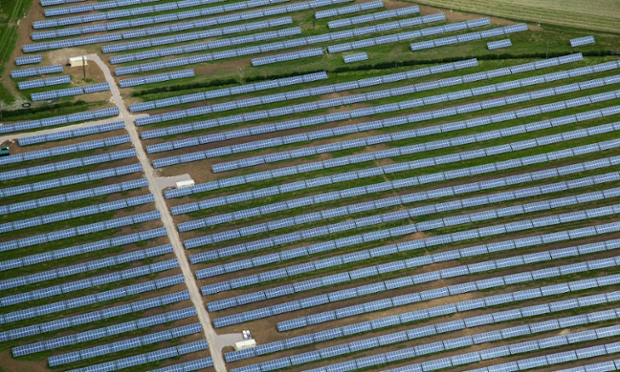Record Boost in New Solar Power Continues Massive Industry Growth
ENERGY, 15 Jun 2015
UK leads European solar energy expansion to help renewables overtake output of nuclear power as industry leaders hail ‘tipping point’ for the technology.
9 Jun 2015 – A record amount of solar power was added to the world’s grids in 2014, pushing total cumulative capacity to 100 times the level it was in 2000.
Around 40GW of solar power was installed last year, meaning there is now a total of 178GW to meet world electricity demand, prompting renewable energy associations to claim that a tipping point has been reached that will allow rapid acceleration of the technology.
“For the first time ever in Europe, renewables produced more power than nuclear – and solar power was key in achieving this remarkable achievement,” said Michael Schmela, executive adviser to trade body SolarPower Europe, which compiled the statistics published on Tuesday [9 Jun].
Britain led the European solar expansion, with government incentives helping to add 2.4GW of solar resources to the domestic market, and a third to Europe’s overall 7GW of growth.
Unofficial sources estimated the British numbers even higher – at up to 3GW – based on an analysis of solar module shipments.
“The success of the UK, set to be the largest European market again in 2015, reinforces the evidence that solar power is a versatile and cost-efficient energy source in any climate,” said James Watson, the CEO of SolarPower Europe, formerly known as the European Photovoltaic Industry Association.
SolarPower Europe argues that to nudge Europe away from fossil fuels, better market access will be crucial for solar in a new EU energy market design proposal expected next year.
Although global growth was impressive, the European pace of development last year slowed to its lowest since 2009, as incentives known as feed-in tariffs were removed across Europe in 2014. Even Germany, the continent’s largest solar market, saw a slight decline in annual installed capacity to 1.9GW, as incentives were cut and market uncertainties increased.
There are fears in Brussels of another solar trade spat with China in the offing, with tough import duties slapped on three Chinese firms last week for violating minimum pricing agreements.
Some German solar panel manufacturers have suffered from state-subsidised Chinese competition. Industry sources though say that the removal of minimum pricing agreements would lower costs in Europe and boost growth across the sector.
China (10.6GW), Japan (9.7GW) and the US (6.5GW) were the three biggest global solar markets last year, with feed-in tariffs, self-consumption measures, tax breaks and net-metering policies all nourishing growth.
One unexpected byproduct of the boom has been that the scale of solar panel distribution between utilities and consumer rooftops has started to balance out. In Europe, the report found that around 40% of solar energy in Europe now comes from utilities, while the amount generated by rooftops has fallen to 60%.
Go to Original – theguardian.com
DISCLAIMER: The statements, views and opinions expressed in pieces republished here are solely those of the authors and do not necessarily represent those of TMS. In accordance with title 17 U.S.C. section 107, this material is distributed without profit to those who have expressed a prior interest in receiving the included information for research and educational purposes. TMS has no affiliation whatsoever with the originator of this article nor is TMS endorsed or sponsored by the originator. “GO TO ORIGINAL” links are provided as a convenience to our readers and allow for verification of authenticity. However, as originating pages are often updated by their originating host sites, the versions posted may not match the versions our readers view when clicking the “GO TO ORIGINAL” links. This site contains copyrighted material the use of which has not always been specifically authorized by the copyright owner. We are making such material available in our efforts to advance understanding of environmental, political, human rights, economic, democracy, scientific, and social justice issues, etc. We believe this constitutes a ‘fair use’ of any such copyrighted material as provided for in section 107 of the US Copyright Law. In accordance with Title 17 U.S.C. Section 107, the material on this site is distributed without profit to those who have expressed a prior interest in receiving the included information for research and educational purposes. For more information go to: http://www.law.cornell.edu/uscode/17/107.shtml. If you wish to use copyrighted material from this site for purposes of your own that go beyond ‘fair use’, you must obtain permission from the copyright owner.


